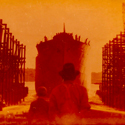Last week I was down in Louisville, Kentucky, where my friends from all over the country met to celebrate the upcoming nuptials of one of the last unmarried holdouts among us. Louisville is a lovely city, and a great location for visiting some bourbon distilleries. My wife gets me a few interesting bottles of bourbon for my birthday every year, and despite its ugly label Buffalo Trace is one of my favorites. It turns out a single distillery can makes dozens of bourbon labels, and even generally crappy brands like Jim Beam or Wild Turkey can make high-quality batches that get different labels. I was excited to see this particular distillery and get a sense of how this uniquely American beverage is made.
This location in Frankfort was supposedly a place where herds of buffalo once crossed the Kentucky River and spirits have been distilled there since before 1773 (the oldest building on the site dates to 1792). Most of the current buildings seemed to have been built between the 1870s and prohibition. We arrived late for the tour we'd planned to attend, which gave us a chance to
wander around the grounds and see the more industrial areas of the
distillery:
I really liked the contrast between the factory-like distilling portion and the barrel-aging buildings that made up most of the tour. It is the aging, after all, that makes bourbon really special and so different from other mass-produced spirits. To be considered a bourbon under federal law, a whiskey must be aged in an unused white oak barrel charred on the inside. So the distillery consists of dozens of massive aging warehouses made of brick or limestone or metal, with the differences imparting different characteristics to the various labels of bourbon aged there. We learned that it can also make a big difference to the bourbon on which floor of the building its barrel spends its life.
The air here smelled incredible. We live across the river from a Canadian whiskey distillery and I'm used to the smell that drifts across on the days the mash is cooking, but that smell was nothing compared to the aroma of those millions of gallons of straight Kentucky bourbon aging on a 90 degree day. The tour guide this has long been called the "angels' share" and it did indeed smell like heaven.
Our tour guide was J.W., the sort of guy who appears to love what he is doing so much that your own joy seems dim and bleak in comparison. "I wish there was anything in this world I enjoyed doing as much as that guy appears to enjoy giving distillery tours," I might have muttered.
One of the coolest part of the tour was the bottling room for the distiller's elite bourbons, where we were given unfettered access to walk around and look and everything. I have been on my share of factory tours where it felt like you were being herded through and not allowed to photograph or even look at certain things. That wasn't the case here. They were bottling single barrel Blanton's that week.
We used to go up to Napa Valley once or twice a year when we lived in California and this was so much better. The buildings here were truly old and functional, not the sort of faux-historical 1990s chateau-grotesque buildings/wedding backdrops most of the winemakers are so proud of out there in wine country. The Buffalo Trace tour was free and included two tastings and a chocolate bourbon ball (how many wineries in Napa still do free tastings?).
Maybe I'm just biased. Tasting wine always makes me feel boorish and clueless. But tasting bourbon makes me feel good.












